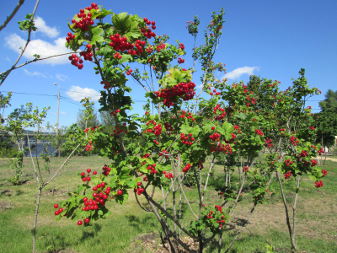












Guelder-rose (Viburnum opulus), fam. Adoxaceae or Viburnaceae.
Widespread both in the city and in the forest (likes quite swamped places). Blooms in May, and its inflorescences are composed of boundary large but sterile flowers, and the true, fertile ones, which are always several days behind in their blooming. There is also a double-flowered ornamental cultivar of guelder-rose called "boule de neige" ("ball of snow" in French), and all its flowers are sterile.
The fruits fully ripen already in October, but many people dislike their bitterness and wait until they are frosted. It is apparently wrong: many berries get moldy by that time, and this is highly undesirable. It would be better to freeze undamaged fruit, or to dry them carefully, or to preserve in honey. The berries also should not be cooked, since it greately increases their unpleasant smell of butyric acid.
Guelder-rose berries have general tonic and immunostimulating effect, and are rich in vitamins. They provide diuretic, choleretic, hemostatic, antiseptic, spasmolytic, vaso-strengthening, hematopoietic, expectorant action. They also have sedative and anti-atherosclerotic effects, stimulate the production of stomach acid, normalizing (usually increasing) the acidity level. With caution guelder-rose berries should be taken by the pregnant, people prone to hypotension and gout, and those with impaired blood clotting.
The common guelder-rose is well-known as one of the symbols of Ukraine, featured in tens of songs and proverbs. Though its practical benefits are small, it pleased the locals with its elegant blooming hundreds of years ago, when the prosperity of introduced ornamental plants that we see around ourselves now was not available. Fire-red fruits can incarnate the undying life of the nature, expecting the new spring, or – the challenging fate of the people.